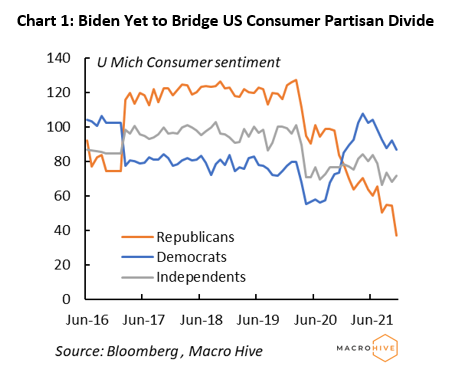

Democrats face an uphill battle to keep control of Congress next year. They have a slim Congressional majority, and the party in the White House typically loses seats in the midterms. Also, President Joe Biden’s job approval has been falling since spring.
Yet 11 months is a long time in politics, and the Democrats might keep control. This could happen three ways.
First, the GOP could become even more unpopular than the Democrats. Since the GOP holds neither Congress nor the White House, losing popularity with voters would require local or grassroots activism. For instance, former President Donald Trump continues to contest the results of the 2020 elections. Should this again prompt large-scale and violent protests, it could put centrist swing voters off.
Second, the US could suffer a new national emergency. For instance, a new Covid variant proves resistant to vaccines; a foreign terrorist undertakes an attack on its soil; or a natural disaster of unprecedented scale hits the country. These situations tend to raise the popularity of the administration in power. Trump’s popularity rose early in the pandemic, as did that of former presidents George Bush after 9/11 and John Kennedy with the Cuban missile crisis.

Third, the Democrats could implement policies more appealing to voters. Below are three issues top of Americans’ minds.
Inflation seems a key driver of Biden’s loss of approval as the cost of living has generally outpaced wages (adjusted for distributional effects). Current high inflation rates are beyond the reach of fiscal and monetary policies, which influence demand with a lag. However, despite the pandemic, corporate profits have soared. The administration could use anti-trust enforcement, regulation, and public pressure to stop large businesses from increasing prices.
After 1.5 years of the pandemic, Americans crave normality over more shots, lockdowns or other government intrusions. The administration’s nationwide vaccine mandate increases the politicization of Covid, is difficult to implement, and makes finding workers harder for businesses. It would be best abandoned and decisions on vaccines and interventions left to the states.
The cost of healthcare is front and centre of every poll of voter concerns. Democrats could lower drug costs by allowing the government to negotiate prices with pharmaceutical companies. They could implement already adopted rules on surprise billing and the publication of hospital tariffs. And they could simplify and remove the uncertainty around the Obamacare subsidy system. All could markedly impact healthcare costs.
The Democrats retaining control of Congress in 2022 would likely see more expansionary fiscal policy than a split White House/Congress. Meanwhile, businesses could face higher regulatory burden and taxation. That said, recent events show adopting measures detrimental to businesses would not only require the Democrats to maintain control of Congress, but the progressives in the party would have to increase their influence.
Of the three paths to Congress remaining blue, the third seems most likely. The administration is already implementing measures that could improve its popularity, for instance on drug prices, Obamacare subsidies and competition policy. And it still has time to refocus policies and shore up voter approval.
Dominique Dwor-Frecaut is a macro strategist based in Southern California. She has worked on EM and DMs at hedge funds, on the sell side, the NY Fed , the IMF and the World Bank. She publishes the blog Macro Sis that discusses the drivers of macro returns.
(The commentary contained in the above article does not constitute an offer or a solicitation, or a recommendation to implement or liquidate an investment or to carry out any other transaction. It should not be used as a basis for any investment decision or other decision. Any investment decision should be based on appropriate professional advice specific to your needs.)
